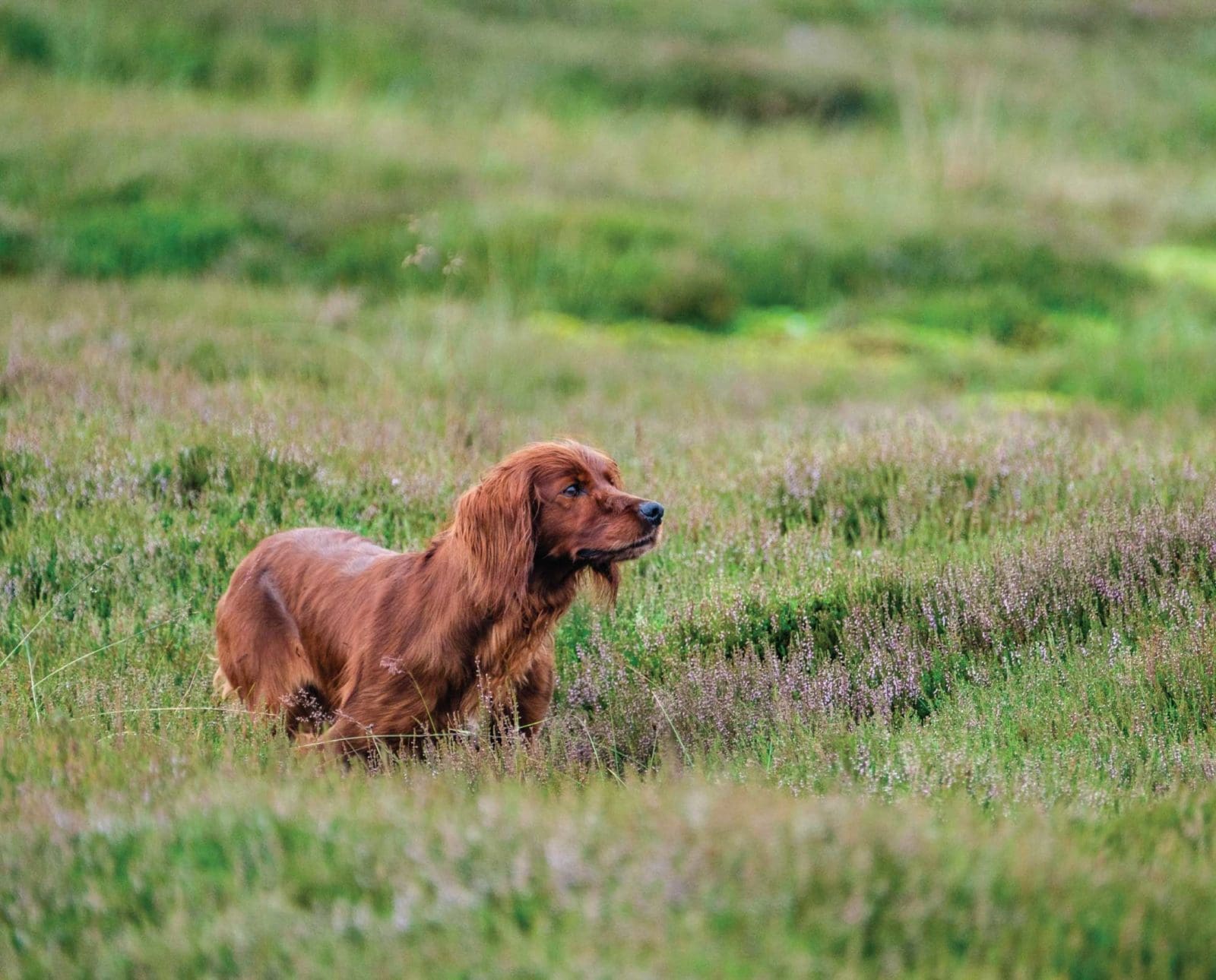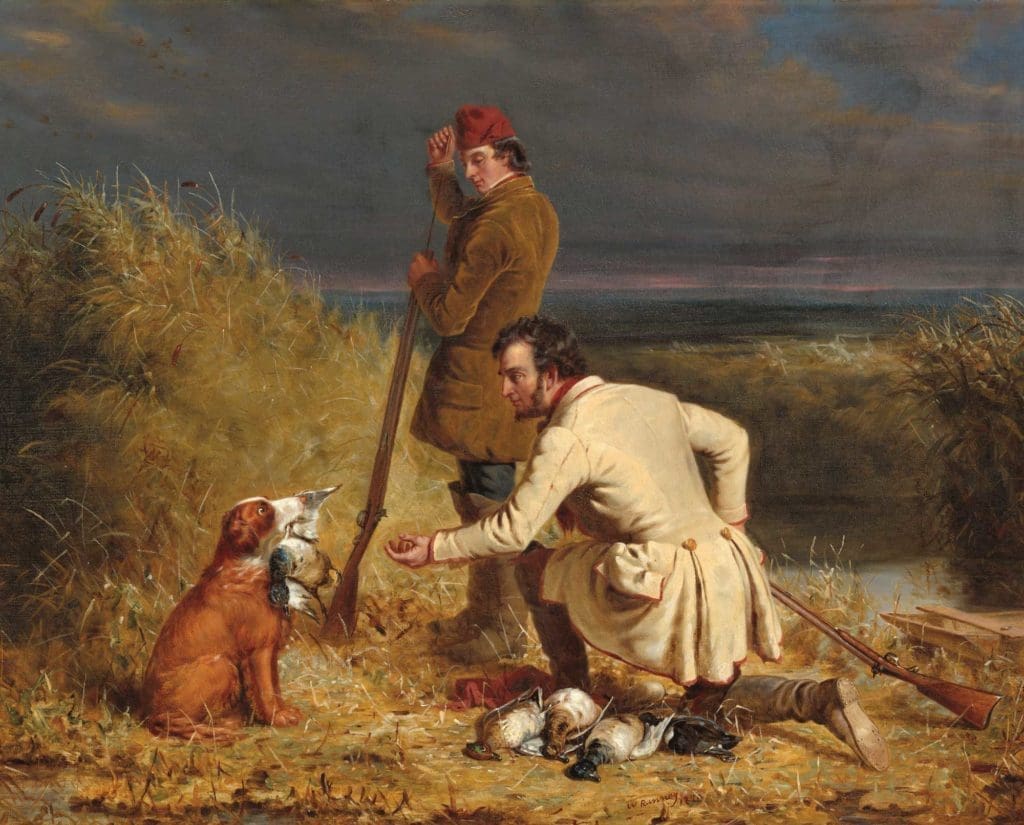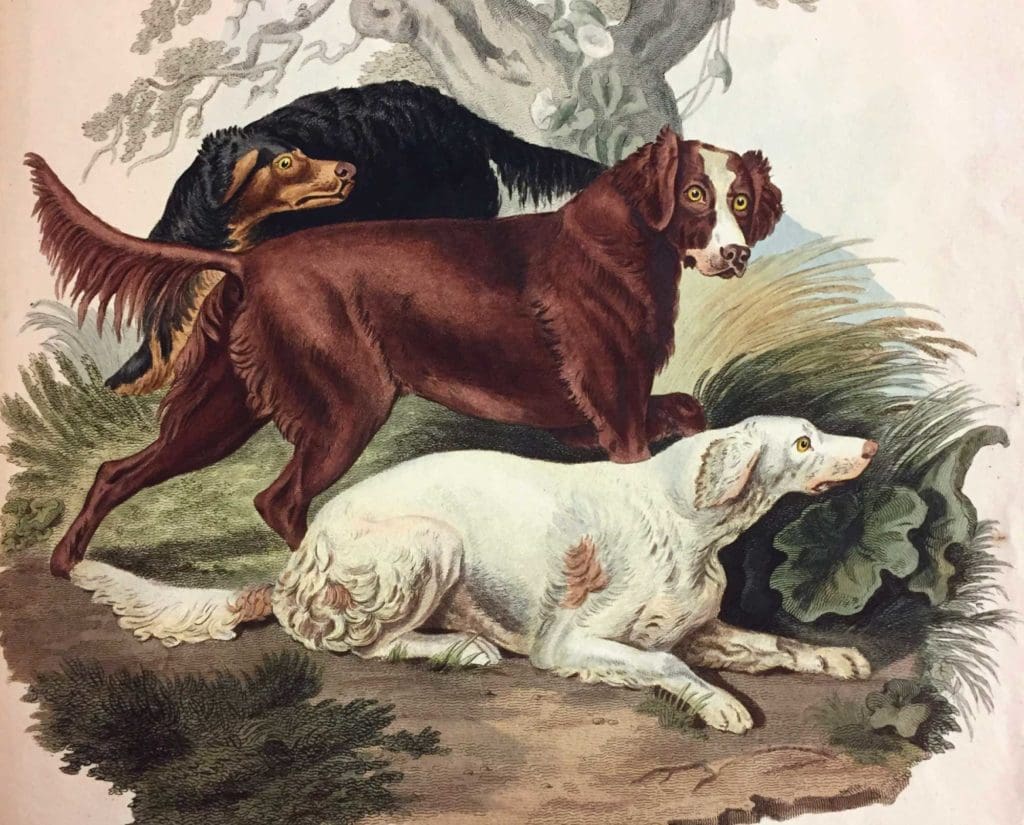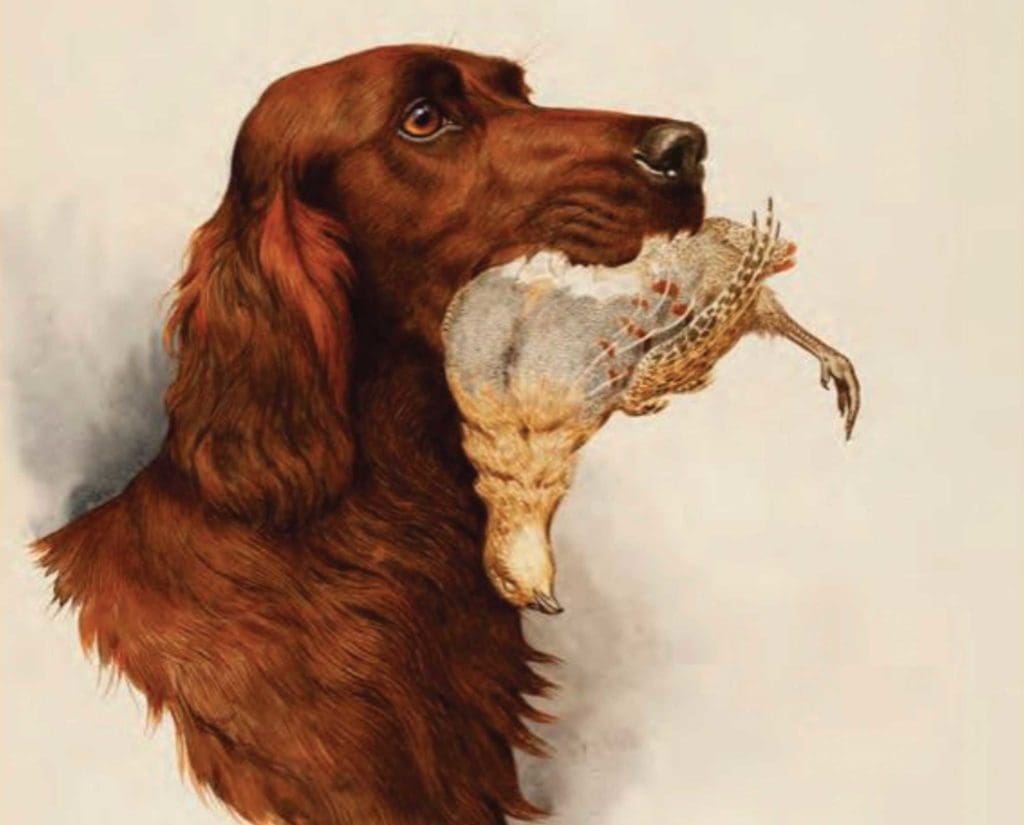Home » Hunting Dogs » Irish Red Setter History in Ireland and America
Irish Red Setter History in Ireland and America

From their home base in Winnipeg, Craig Koshyk and Lisa…
The Irish Red Setter, like many dog breeds, has a complex history that shaped the dog we love today.
Irish Red Setters descend from the same rootstock that gave rise to all the setter breeds. However, there is good reason to believe they may be the oldest of them all. The spaniels that became setting dogs were in Ireland since at least the 16th century. During this time, the landscape of the island was quite different from what it is today. In his book on Irish Setters, Gilbert Leighton-Boyce wrote:
Listen to more articles on Apple | Google | Spotify | Audible
Picture, if you will, Ireland without coniferous plantations, mechanized peat extraction, for artificial drainage. You will see a land of wide horizons and great expanses of heather—a land of mountain and bog. The vast expanses of heather held red grouse, snipe, and woodcock. The better land supported decent stock of gray partridge and some introduced pheasants. With the advent of firearms, Ireland was a paradise for the hunter. Although game was never over-abundant, there was certainly sufficient to attract the attention of those who enjoyed the pleasures of hunting with dogs in a wild and beautiful countryside and where variety took the place of huge bags. The interaction of landscape, game, and breeders developed the two setter breeds that are native to Ireland.

Early Irish Setter Breed Developments
During the earliest period of setter development, trade and communication links between Ireland and the European continent were stronger and more stable than they were between England and the continent. France and Ireland, in particular, were closely linked. People had been migrating between the two countries for centuries. Irish men served in some French armies and even accompanied French explorers to the new world.
The Spread Of Setters
The first written mentions of setting dogs crossing the English Channel are from English sources. That said, similar transactions could very well have taken place in Ireland around the same time. Colonel J.K. Millner wrote in The Irish Setter – Its History & Training:
The Irish country gentlemen followed sport much the same as their fellows in England did and used spaniels in the days of hawking. These dogs must have come directly from Spain or France or even through England. The south and western coasts of Ireland had considerable commerce with Spain, and many English sportsmen who came over and settled in the Emerald Isle probably brought their dogs. Dogs have been used in Ireland for hunting from the most remote times, and the remains of two sorts of dogs are found among the prehistoric Irish deposits, one being large and the other small.
Gilbert Leighton Boyce also mentioned a possible French connection. He write that “both England and Wales have some ground for claiming the honor of starting what Ireland later made her own.” However, several paintings by Van Dyke concluded that “red setters with or without white markings could possibly be neither English nor Welsh in origin but have developed in Navarre,” a region which makes up parts of modern-day France and Spain.
Historical Irish Setter Strains
Some dogs back then traced their origins to strains developed by wealthy sportsmen before the uprising of 1798. Others were the descendants of dogs owned by modest country gentlemen who occasionally bred a litter or two. None of the early breeders kept detailed pedigrees. However, there are records going back to the early 1800s of certain well-known strains.
E. Irving Eldridge and Connie Vanacore wrote in The New Complete Irish Setter:
One of the first Irish sportsmen to rent shooting moors in Scotland (1779) was Maurice Nugent O’Connor, whose red setters had a trace of white on them, but no black. At his death in 1818, Robert LaTouche acquired the dogs…The French Park strain was owned in succession by three generations of the Lord de Freyne family (1793-1879). Then there were the strains of the Marquis of Waterford, Mr. Mahon, Lord Clancarty, Lord Anglesey, Lord l ismore. Lord Dillon, Lord Rossmore, Lord Forbes, Lord Howth, Sir Frances H. Loftus, Sir George Gore, Earl of Enniskillen, Yelverton O’Keefe, the Misses Lid well and many others. John G. King was known as the “Father of the Breed” and Harry Blake Knox was the first to speak of the breed as the “Irish Red Setter.”
Back then, bird dogs were selected for their natural hunting abilities and style. Naturally, some breeders may have preferred a red and white coat and others a solid red coat. There were no breed clubs or registries around to guide their breeding efforts. The “standards” they followed were determined by the game and terrain they hunted and modified to suit their personal taste. Nevertheless, by 1800, the overall look of the breed was established. We can easily identify Irish Setters in paintings from that era.

Irish Setters in America
Irish Setters first began to appear in America in the mid-1860s. They soon developed a reputation for being an “all-round” breed better suited to harsh conditions than the English Setter or Pointer.
Until 1878, imported Irish Setters and Native Irish Setters were registered and shown separately. In early American dog shows, solid red Irish Setters and red and whites were shown in the same class. There were also classes for cross-bred dogs in which Irish-Gordons or Irish-English Setters could be shown.
The Early Days
In the early days of American field trials, the Irish Setter figured very prominently in all the contests. It won about as much as any of the other breeds. Those dogs of the 1870s and ’80s were the equal of any breed in the strongest of competition. As a general-purpose field dog, Irish Setters were more in use than either Pointers or English Setters.
Despite the early successes, by the late 1800s, the numbers of Irish Setters appearing in field trials plummeted. However, many were still kept by hunters. Unfortunately, the admiration of practical sportsmen was not enough to protect the working Irish Setter in America. In 1912, J.B. Thompson wrote:
The rage for the dark mahogany color on the bench sounded the death knell to his field greatness. Individuals, a trifle off-color, that would have materially assisted in perpetuating the hunting instincts through generations, were curtly put aside as breeders, and in their stead were substituted animals having the favored coloring of coat so appealing to the eye, but hunting ability unknown.
Post-WWI
After the First World War, the popularity of the Irish Setter reached new heights, at least in the show ring. According to Irving Eldredge, the results “led to wide variations in breed size and type—as far apart as Spaniels, Whippets, Pointers, and St. Bernards, except in color.”
The breed’s popularity soared in the ring and pet market. At the same time, a renewed effort led by men like Dr. John DeRonde, the president of the Irish Setter Club of America, acted to increase the number of Irish Setters in field trials. Unfortunately, despite the valiant efforts of a few remaining stalwarts, hopes of reviving the working Irish Setter in America faded. Show dogs numbers grew exponentially. The number of dogs capable of competing at the highest levels of field trials dramatically declined.
Not only did Pointer and setter breeders have a more progressive sporting orientation, they outnumbered Irish Setter breeders a hundred to one. They also had growing populations of outstanding field-bred dogs to choose from. And then, as if things couldn’t get any worse, disaster struck. Three of the most ardent working Irish Setters supporters in America died of the Spanish flu: Dr. Davis, F. A. Johnson, and Otto Pohl.

Decline of the Irish Setter in America
By the late 1940s, the Irish Setter as a working gundog in America was in rough shape. Sure, there were still a few red dogs running in field trials. Once in a blue moon, they won an important stake. In some regions, they were still bred by hunters, for hunters, and used for upland and waterfowl hunting. But many of the breed’s most ardent supporters could see the writing on the wall. If they ever wanted to see the breed regain its position as a world-class bird dog, they knew they’d have to take drastic measures.
Horace Lytle’s Call To Action
In January 1950, Horace Lytle wrote an article for Sports Afield. It in, he described the sorry state of the Irish Setter in America. Lytle ended it with a call to action. Lytle’s article is considered a major turning point in the history of the Irish Red Setter in America. But when it first appeared, it ignited a firestorm of protest. Within days of publication, the offices of Sports Afield were inundated with letters from irate readers. They were so enraged by the suggestion of cross-breeding, they threatened to cancel their subscriptions. Companies threatened to pull their advertisements from the magazine. The protests were so strong and sustained, Lytle ultimately lost his job.
Soon, The American Field published an article by Henry Betten supporting Lytle’s position. According to the NRSFTC website, the article was a “blistering dissertation” that called for a return to the glory days of Joe Jr. and the success of the native-bred setters. “Back to the beginning and a fresh start from scratch, minus the mistakes, and under the direct guidance of the sporting faithful!” Betten wrote.
Ned LeGrande’s Speech On Reviving Irish Setters
On the 25th anniversary of the National Red Setter Field Trial Club, Ned LeGrande gave a speech. He explained that even before the Lytle and Betten articles appeared, he and others were already dreaming of reviving the working Irish Setter in America:
During the late forties and early fifties when I used to spend a lot of time, especially nights, hanging around Rusty Baynard’s gasoline station, the Red Setter was then a pretty common bird dog. Herm David, too, used to join us when he was in town, and the three of us used to talk, and dream, by the hour about Red Setters with high tails that would point early, break as derbies, and be able to run with and whip the Pointers in field trials. The Red Setter enthusiasts of today can’t realize how impossible those goals seemed in 1949.
LeGrande and the others weren’t just dreaming about the type of Red Setter they desired; they scoured the country looking for them. These folks wrote letters, visited breeders, and placed ads in the American Field newspaper. They aggressively sought the best remaining working lines of Irish Setters in America. They even ran some of the dogs they managed to find in field trials. Yet they continued to come up short. They simply could not find the setters they were looking for.
Askew’s Carolina Lady And Unavoidable Crossbreeding
Then, LeGrande heard about an outstanding female owned by a farmer in Enfield, North Carolina. But before he could buy her, he had to convince her owner to sell her. LeGrande later recalled that he didn’t want to let her go, but “we sat down over a jug of cider, and finally, he said, ‘Everything I raise is for sale.’” LeGrande ended up purchasing the dog, named Askew’s Carolina Lady. After an exceptional field trial career, she became the first Irish setter to be inducted into the Field Trial Hall of Fame.
But even Askew’s Carolina Lady wasn’t enough, although she did produce a number of outstanding pups. So, they concluded that their only recourse was to follow Horace Lytle’s advice. They must undertake a program of cross-breeding to English Setters.
In interviews and articles in the sporting press, supporters of the program pointed out that even Edward Laverack and Llewellin used Irish Setters to create their lines of English Setters. Cross-bred English-Irish dogs were common in America in the late 1800s. In fact, the winner of America’s very first formal field trial was an English-Irish Native Setter.
Revival of the Red Setter
“Back in 1951, the small handful of us who were running our Irish Setters in breed-open-field trials rallied around Ned LeGrande . . . a new and somewhat fabulous energy on the scene. We had in common an illogical delight in the challenge to prove the Irish Setter as a bird-dog. Perhaps it was the crude jokes we heard when we would put one of our red ones on the starting lines that fixed our determination—or perhaps it was an unreasonable compulsion to champion a literal underdog.” – Herm David
Before attempting the first crosses, LeGrande consulted with Dr. Leon Whitney, a Yale-educated authority on dog genetics. LeGrande later said, “Whitney advised us to get the best English setter possible and to make sure that we got one with red or orange spots, or otherwise we’d wind up with black dogs.”
As a result, LeGrande used dogs like Illsley Chip, an orange and white son of National Champion Mississippi Zev. Crossing Illsley Chip to a bitch named Willow Winds Smada produced a “. . . kind of a straw-colored litter and we bred them back to sons and daughters of Askew’s Carolina Lady. We kept the Field Dog Stud Book informed of every breeding. Nothing was kept secret. We also started the National Red Setter Field Trial Club because the Irish Setter Club in the AKC wanted none of this.” The cross-bred pups were then bred back to purebred Irish Setters. After the agreed upon number of generations, the descendants were registered as Irish Setters.
The Irish Connection
When word of the American cross-breeding Purest Challenge program reached Ireland, reactions were mixed. Naturally, supporters of working Irish Setters applauded the effort to revive the breed as a gun dog in America. However, many considered cross-breeding to setters unnecessary and risky. Legendary Irish breeder John Nash raised the two main objections against American-bred dogs: they have a rocky gallop and “may inherit a reluctance to go in and flush their game.”
Red Setters in American Field Trials
But Ned LeGrande and his supporters were not interested in breeding Red Setters for Irish or English field trials. Nor were they trying to produce gun dogs suitable for the game and terrain of England or Ireland. LeGrande was laser focused on developing Irish Red Setters that could go toe-to-toe against Pointers and Setters in American field trials. By the 1950s, that meant producing dogs with extraordinary speed, range, bird handling abilities, and a “high tail.”
LeGrande spent a great deal of time and effort looking for high-tailed Irish Setters; they were as rare as hen’s teeth. Meanwhile, every major English Setter kennel in the country was full of dogs with “12 o’clock” tails. He was left with a choice: selectively breed among Irish Setters for high tails, something that would surely take decades, or cross to an English Setter and start to get high tails in a single generation.
Nash’s concern for ending up with dogs having “a very great inherent reluctance to go in and flush their game” was a non-issue. After all, in American field trials, after a dog goes on point, it must remain absolutely motionless as the handler moves in front of it and flushes the bird. Most American hunters also expect to flush birds themselves and expect their dog to stay put on point. A sticky dog is not a problem. For many, it would be considered a good thing!
The Loss Of John Nash
Crosses to English setters started in the 1950s and continued for years. Sadly, John Nash never made it to America to see and judge the dogs produced by the Purest
Challenge program. He was killed when a branch from a large old tree fell on him during a windstorm as he was handling dogs for a shooting party. Shortly after the tragic event, Bob Sprouse’s tribute to Nash was published in the Irish Setter club of Ireland’s annual newsletter. In it, Sprouse lamented the loss of his friend and the fact that American breeders missed a tremendous opportunity to use more of Nash’s dogs in their program.
It is sad that John Nash died at a time when his dogs were just beginning to be fully appreciated for the contribution they could make to our native lines. We are hoping that his work will be carried on by his friends all over the world. The members of the National Red Setter Club U.S.A. extend their utmost sympathy to the family of John Nash and the members of The Irish Red Setter Club. John Nash will be missed and remembered in America as well as in his homeland.
Only limited amounts of blood from Irish and English imports have made their way into American Red Setter lines. The few Irish imports that have come over were brought in by hunters for their own personal use as hunting dogs, not for any specific breeding program or to participate in field trials. Yet, despite the divergence in sporting cultures and different approaches to breeding, supporters of the Irish Setter on both sides of the Atlantic continue to enjoy a relationship of mutual respect and admiration.
From their home base in Winnipeg, Craig Koshyk and Lisa Trottier travel all over hunting everything from snipe, woodcock to grouse, geese and pheasants. In the 1990s they began a quest to research, photograph, and hunt over all of the pointing breeds from continental Europe and published Pointing Dogs, Volume One: The Continentals. The follow-up to the first volume, Pointing Dogs, Volume Two, the British and Irish Breeds, is slated for release in 2020.




This is a most illuminating article. Its author may be interested in reading my book: ‘The Curious History of Irish Dogs’.
The book focuses on the social history of our nine native breeds and how these dogs were closely connected with social and political developments in Ireland.
Two of the chapters in the book are devoted to Irish Red Setters and two to Irish Red and White Setters.